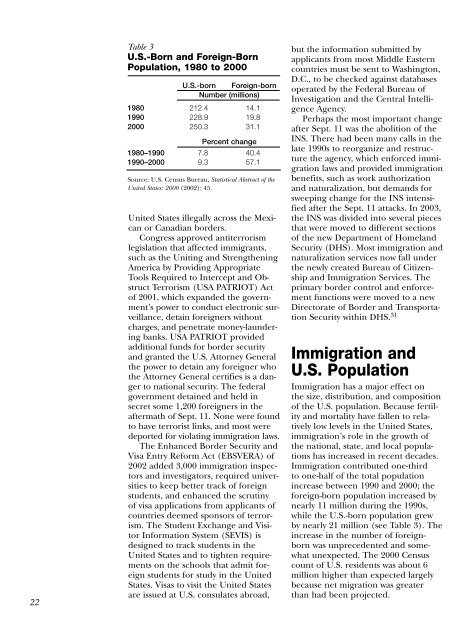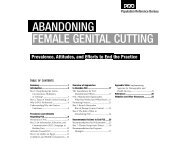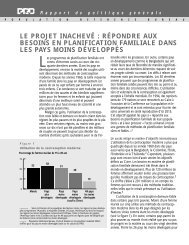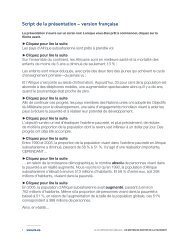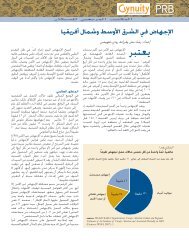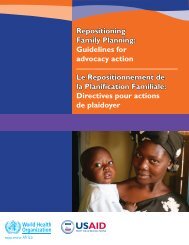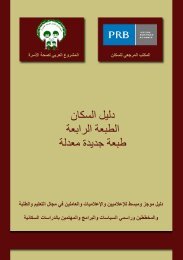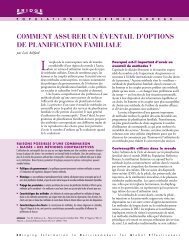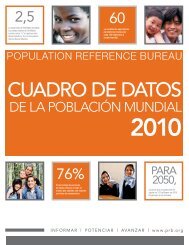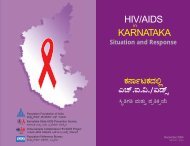Immigration Shaping America - Population Reference Bureau
Immigration Shaping America - Population Reference Bureau
Immigration Shaping America - Population Reference Bureau
You also want an ePaper? Increase the reach of your titles
YUMPU automatically turns print PDFs into web optimized ePapers that Google loves.
22<br />
Table 3<br />
U.S.-Born and Foreign-Born<br />
<strong>Population</strong>, 1980 to 2000<br />
U.S.-born Foreign-born<br />
Number (millions)<br />
1980 212.4 14.1<br />
1990 228.9 19.8<br />
2000 250.3 31.1<br />
Percent change<br />
1980–1990 7.8 40.4<br />
1990–2000 9.3 57.1<br />
Source: U.S. Census <strong>Bureau</strong>, Statistical Abstract of the<br />
United States: 2000 (2002): 45.<br />
United States illegally across the Mexican<br />
or Canadian borders.<br />
Congress approved antiterrorism<br />
legislation that affected immigrants,<br />
such as the Uniting and Strengthening<br />
<strong>America</strong> by Providing Appropriate<br />
Tools Required to Intercept and Obstruct<br />
Terrorism (USA PATRIOT) Act<br />
of 2001, which expanded the government’s<br />
power to conduct electronic surveillance,<br />
detain foreigners without<br />
charges, and penetrate money-laundering<br />
banks. USA PATRIOT provided<br />
additional funds for border security<br />
and granted the U.S. Attorney General<br />
the power to detain any foreigner who<br />
the Attorney General certifies is a danger<br />
to national security. The federal<br />
government detained and held in<br />
secret some 1,200 foreigners in the<br />
aftermath of Sept. 11. None were found<br />
to have terrorist links, and most were<br />
deported for violating immigration laws.<br />
The Enhanced Border Security and<br />
Visa Entry Reform Act (EBSVERA) of<br />
2002 added 3,000 immigration inspectors<br />
and investigators, required universities<br />
to keep better track of foreign<br />
students, and enhanced the scrutiny<br />
of visa applications from applicants of<br />
countries deemed sponsors of terrorism.<br />
The Student Exchange and Visitor<br />
Information System (SEVIS) is<br />
designed to track students in the<br />
United States and to tighten requirements<br />
on the schools that admit foreign<br />
students for study in the United<br />
States. Visas to visit the United States<br />
are issued at U.S. consulates abroad,<br />
but the information submitted by<br />
applicants from most Middle Eastern<br />
countries must be sent to Washington,<br />
D.C., to be checked against databases<br />
operated by the Federal <strong>Bureau</strong> of<br />
Investigation and the Central Intelligence<br />
Agency.<br />
Perhaps the most important change<br />
after Sept. 11 was the abolition of the<br />
INS. There had been many calls in the<br />
late 1990s to reorganize and restructure<br />
the agency, which enforced immigration<br />
laws and provided immigration<br />
benefits, such as work authorization<br />
and naturalization, but demands for<br />
sweeping change for the INS intensified<br />
after the Sept. 11 attacks. In 2003,<br />
the INS was divided into several pieces<br />
that were moved to different sections<br />
of the new Department of Homeland<br />
Security (DHS). Most immigration and<br />
naturalization services now fall under<br />
the newly created <strong>Bureau</strong> of Citizenship<br />
and <strong>Immigration</strong> Services. The<br />
primary border control and enforcement<br />
functions were moved to a new<br />
Directorate of Border and Transportation<br />
Security within DHS. 31<br />
<strong>Immigration</strong> and<br />
U.S. <strong>Population</strong><br />
<strong>Immigration</strong> has a major effect on<br />
the size, distribution, and composition<br />
of the U.S. population. Because fertility<br />
and mortality have fallen to relatively<br />
low levels in the United States,<br />
immigration’s role in the growth of<br />
the national, state, and local populations<br />
has increased in recent decades.<br />
<strong>Immigration</strong> contributed one-third<br />
to one-half of the total population<br />
increase between 1990 and 2000; the<br />
foreign-born population increased by<br />
nearly 11 million during the 1990s,<br />
while the U.S.-born population grew<br />
by nearly 21 million (see Table 3). The<br />
increase in the number of foreignborn<br />
was unprecedented and somewhat<br />
unexpected. The 2000 Census<br />
count of U.S. residents was about 6<br />
million higher than expected largely<br />
because net migration was greater<br />
than had been projected.


